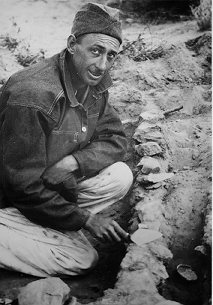Lost City Museum
History
|
The Lost City Museum was built by the
national Park Service to exhibit artifacts that were being
excavated from the Pueblo Grande de Nevada. These Anasazi
Indian sites were being threatened by the waters of Lake
Mead as it backed up behind the newly built Hoover Dam.
Eventually, when the lake was filled to capacity about five
miles of sites had been inundated or undercut by the
water.
The Civilian Conservation Corps assisted
in the excavation of the sites and the construction of the
museum building. The building was constructed of sun-dried
adobe brick in a pueblo-revival style. The museum also
served as the park headquarters for the Boulder Dam State
Park that was established at Lake Mead.
The museum is currently owned and
maintained by the State of Nevada as one of its six state
museums. Programs include ongoing archaeological research on
the remaining Lost City sites, school tours and outreach
programs, changing exhibits and archival library and
collections, research capabilities. Festival Americana,
celebrating Native American and pioneer crafts, music and
food, is held the first Saturday in November.
|

Photo on display in museum.
|
Nevada's Lost
City
Nevada's "Lost City", officially known as Pueblo
Grande de Nevada is a series of Anasazi Indian ruins situated along
the Muddy and Virgin River Valleys in southern Nevada. The site area
is located at the northern end of man-made Lake Mead and continues up
both valleys for a distance of approximately 30 miles. There are more
than a 100 recorded sites along the Muddy River and over 50 recorded
sites along the Virgin River. The Lost City was occupied by the
Virgin branch of the Anasazi, originally by the Basketmaker people
sometime after the first century A.D. and later by the Puebloans from
A.D. 700 to 1150. Some of the sites were reoccupied by the Paiute
Indians who moved into the area after A.D. 1000. The Basketmakers
lived in sub-terrain pit houses that were 10 to 15 feet in diameter
and approximately 6 feet deep. They used spears for hunting and their
name is derived from their use of baskets as storage vessels. The
later Puebloans lived in above ground pueblos (houses made of sticks
and adobe). They had the additional knowledge of the bow and arrow
and manufactured ceramic vessels for storage and cooking.
The Anasazi farmed corn, beans, squash, and cotton on
the marshy valley floor and built multi-roomed pueblos on the gravel
benches along the valley margins. In addition to farming and hunting
natural resources, the Lost City Anasazi mined salt and turquoise
both for their own personal use and as a highly valued trade item.
Remnants of all these activities were found during the excavations of
the site ruins.
The Lost City ruins were first noted by explorer
Jedidiah Smith when he traveled throughout the area in 1826-27. He
reported finding stone tools in salt caves along the Virgin River
where Lake Mead stands today. Smith's report later aroused the
interest of Nevada's Governor James Scrugham. He inquired about the
locality and two brothers from Overton, John and Fay Perkins
announced their "discovery" in 1924. Scrugham arranged for M.R.
Harrington, a New York archaeologist who was excavating in northern
Nevada at the time, to investigate the sites.
Harrington immediately recognized the artifacts as
belonging to a Puebloan culture. Until that time, it was believed
that the Puebloan Indians had not settled west of the Colorado River
in southern Nevada. Harrington named the complex Pueblo Grande de
Nevada because of it's large size, but the media picked up the term
"Lost City" and that became it's popular name.
|

|
Harrington, under the auspices of the Heye
Foundation, Museum of the American Indian in New York City,
began excavations of the Lost City in 1924 and continued
work there even after his move to the Southwest Museum in
Los Angeles in 1928. In addition to his work on the Anasazi
sites, Harrington found time to excavate several caves in
the area and an ancient salt mine. From 1933 to 1938, he
supervised members of the Civilian Conservation Corps as
they aided in the excavations and built the Boulder Dam Park
Museum(now Lost City Museum of Archaeology) in Overton to
house the artifacts.
When the museum was built in 1935,
Harrington designed the exhibits and constructed many of the
exhibit props himself. The museum originally served as the
headquarters for the National Park service's Boulder Dam
Park, which is today the; Lake Mead National Recreation
Area.
|
The Park Service withdrew from the operations of the
museum in 1952 and ownership was transferred to the State of Nevada
in 1953. Today the museum stands as one of the most popular tourist
attractions in southern Nevada. More than 50,000 visitors a year find
their way off the beaten track to learn about the ancient cultures
that once occupied this corner of Nevada.
Archaeological research continues to be an important
aspect of the museum's operations. Museum staff members can often be
found one step in front of bulldozers as the ancient sites are
removed to make way for modern housing tracts. The museum, through
receipt of a grant from the Fleischmann Foundation, was able to
purchase several sites in recent years in an effort to preserve them
for future generations. Research, preservation and education remain
the primary goals of the Lost City Museum of Archaeology.
Bibliography
Harrington, M. R. in cooperation with the Clark County Nevada
Archeological and Historical Society, Ancient Tribes of the
Boulder Dam Country. Southwest Museum, Highland Park, Los
Angeles, California.
Olson, Kathryne and Pat, Nevada's Lost City, A Treasure
Trove of Mystery, SPO, Carson City Nevada, 1985.
Houk, Rose, Anasazi-Prehistoric Cultures of the
Southwest, Southwest Parks and Monuments Association, Tucson,
Arizona, Library of Congress Number 91-67394, ISBN 1-877856-04-5.
Return
to Home Page
Map-Directions
from Las Vegas, Nevada
|
Museum
Artifacts
|
History
|
Just for
Teachers
|